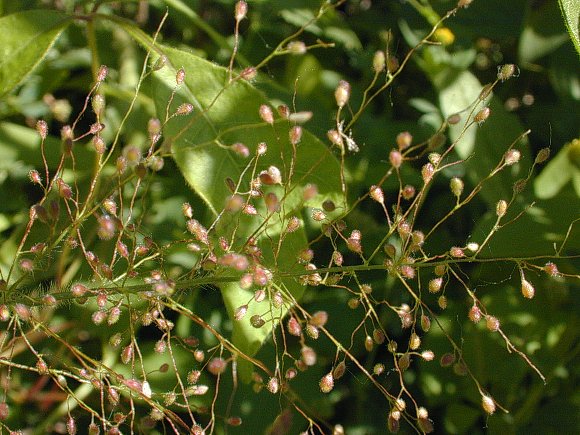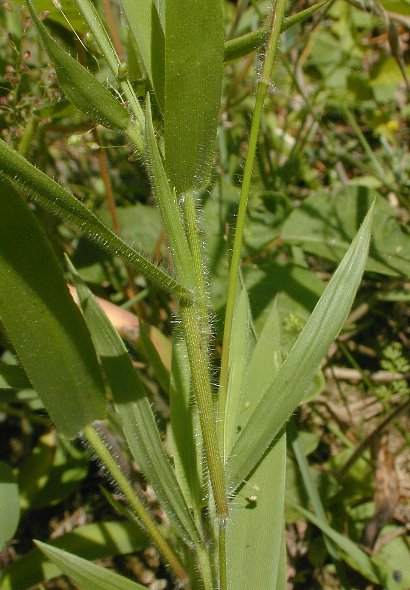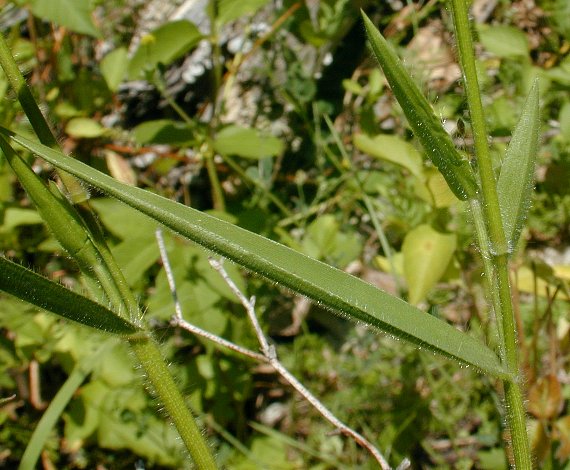Description: This perennial grass is tufted at the base, sending out multiple culms that are erect to spreading and up to 2½' long. The culms are green to reddish green and terete, branching occasionally to produce lateral stems. The nodes of these culms have long white hairs; sometimes the culms are reddish near the nodes. Alternate leaves occur along the entire length of each culm. The leaf blades are up to 4" long and 10 mm. across; they are narrowly lanceolate, green, and flat. The upper blade surface is hairless or sparsely covered with short white hairs, while the lower blade surface is more or less hairy. The lower margins of leaf blades are often ciliate with long white hairs. The leaf sheaths are green, longitudinally veined, and heavily covered with long white hairs. Each culm terminates in a panicle of spikelets up to 4" long and about one-half as broad. The rachis of the panicle has long spreading hairs, particularly along its lower half. The slender branches and branchlets of the panicle are usually glabrous, slightly wiry, and spreading to ascending, ultimately terminating in pedicellate one-flowered spikelets. These spikelets are 1.5–2 mm. long, green to purple, conspicuously pubescent, and ovoid to obovoid in shape; they later become tan.

The smaller glumes are
about one-fourth to one-third the length of the spikelets, while the
lemmas and
larger glumes are about the same length as the spikelets. The lateral
stems of the culms often terminate in panicles of spikelets as well,
although they are smaller in size. The primary blooming period
typically occurs during early summer, lasting about 1-2 weeks for a
colony of plants. The florets of the spikelets are cross-pollinated by
the wind. After the vernal phase of
development, this grass, like other Dichanthelium spp.,
dies down during mid- to late summer. During the autumnal phase
of development, this grass regenerates itself and forms a low rosette
of spreading culms and leaves. Sometimes panicles of spikelets are
formed, and a second blooming period may occur during the autumn. Each
spikelet produces a single grain; the grains are about 1.5 mm.
long, broadly ellipsoid, and slightly
flattened. The root system is fibrous. This
grass spreads by reseeding itself.
Cultivation:
The preference is light shade to full sun and moist to dry conditions.
Different kinds of soil are tolerated, including those containing loam,
clay-loam, rocky material, and sand. This grass has a tendency to die
out if it competes with taller ground vegetation.

Range &
Habitat:
Woolly Panic Grass occurs in all counties of Illinois (see Distribution
Map), where it is native and common. Habitats include
openings in upland woodlands, openings in sandy woodlands, typical
savannas and
sandy savannas, disturbed meadows in wooded areas, disturbed areas of
mesic to dry prairies, sand prairies, sandstone glades, thinly wooded
bluffs,
powerline clearances in wooded areas, and old fields. Less often, this
grass can be found in open wetland areas, such as sandflats, but this
is unusual. Woolly Panic Grass prefers disturbed areas with reduced
ground
vegetation and it has low fidelity to any particular habitat.
Faunal Associations:
The caterpillars of several skippers feed on the foliage of panic
grasses (Panicum spp. and Dichanthelium
spp.), including Hesperia sassacus
(Indian Skipper), Poanes hobomok (Hobomok Skipper),
Polites themistocles (Tawny-edged Skipper), and Wallengrenia
egremet (Northern Broken-Dash). Other insect species that
feed
on these grasses include leaf-mining larvae of moths (Elachista spp.),
the leaf beetle Chalepus
bicolor, larvae of the gall fly Calamomyia panici,
the stilt bug Jalysus
spinosus, plant bugs (Collaria
spp.),
the stink bug Mormidea
lugens, the leafhopper Polyamia rossi,
Prociphilus
erigeronensis (Erigeron Root Aphid) and other aphids, and Arphia
sulphurea (Sulphur-winged Grasshopper); see the Insect
Table for more information. The seeds of panic grasses are an
important source of food to many birds, particularly upland gamebirds
and granivorous songbirds (see the Bird Table for a listing of these
species). Panic Grasses are eaten occasionally by the Cottontail Rabbit
and hoofed mammalian herbivores (primarily livestock); the foliage of
these
grasses is palatable while it is young (Martin et al., 1951/1961).

Photographic
Location:
A powerline clearance at Busey Woods in Urbana, Illinois.
Comments:
This is one of the more common panic grasses (Dichanthelium
spp.) in Illinois. It used to be referred to as Panicum
lanuginosum
fasciculatum, however the shorter panic grasses have been
separated into their own genus. These panic grasses bloom during the
late spring or early summer, die down during mid- to late summer, and
develop low rosettes during the fall, at which time they may bloom
again. Those grasses remaining in the Panicum genus
tend to be taller warm-season grasses that bloom from mid-summer to the
early fall, after which they die down and become dormant during the
winter. There are several varieties of Woolly Panic Grass (Dichanthelium acuminatum)
that are
difficult to distinguish and sometimes intergrade in the
field; see Mohlenbrock (2001) for a description of these
varieties. The variety that has been described here,
var. fasciculatum, is
the most common of these varieties in Illinois. Woolly Panic Grass can
be identified by its
pubescent spikelets, the hairiness of the lower rachis in the
inflorescence, and the length of its spikelets (1.5–2.0 mm.). Other
panic grasses may have hairless spikelets, a hairless rachis in the
inflorescence, and spikelets that are either longer or shorter in
length.
Sometimes the relative hairiness of the sheaths and leaf blades (both
upper and lower surfaces) can be used to distinguish different
varieties or species of panic grasses.